- Home
- Prelims
- Mains
- Current Affairs
- Study Materials
- Test Series
Feb 14, 2022
INCOIS PREPARES COASTAL VULNERABILITY INDEX
Indian National Centre for Ocean Information Services (INCOIS) has carried out coastal vulnerability assessment for entire Indian coast at states level to bring out an Atlas comprising 156 maps on 1:1,00,000 scales to prepare a Coastal Vulnerability Index (CVI).
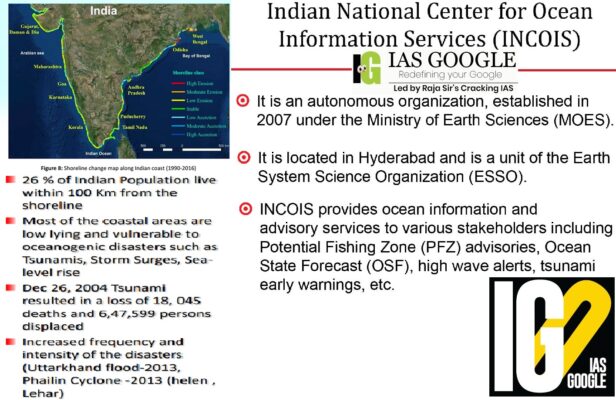 Coastal Vulnerability Index
Coastal Vulnerability Index
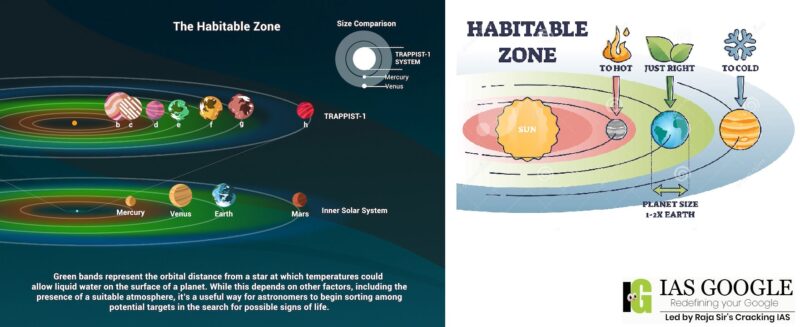 Multi-Stage Memetic Binary Tree Anomaly Identifier (MSMBTAI)
Multi-Stage Memetic Binary Tree Anomaly Identifier (MSMBTAI)
 Who are minorities?
Who are minorities?
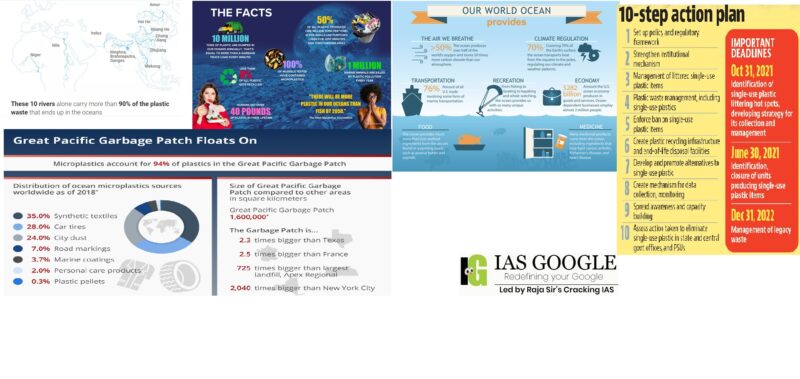 About Plastic
About Plastic
 Need for Sea-bed Mapping?
Need for Sea-bed Mapping?
 Structural Vulnerabilities and what led to structural vulnerabilities?
Structural Vulnerabilities and what led to structural vulnerabilities?
 Why crimes against women?
Why crimes against women?
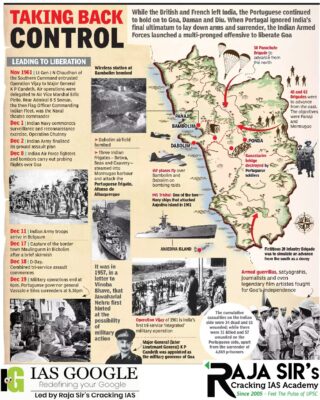 Freedom Movement in Goa
Freedom Movement in Goa
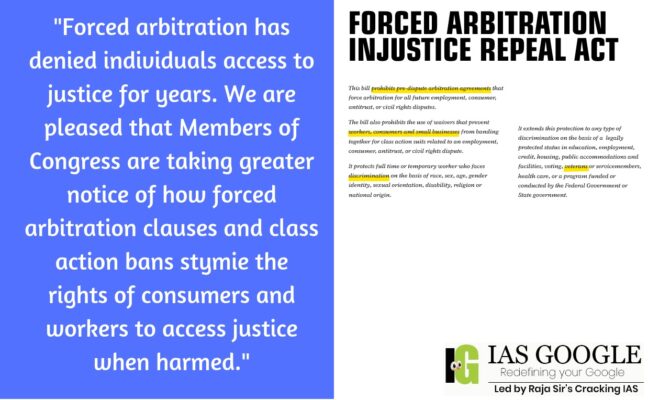 What is forced arbitration?
What is forced arbitration?
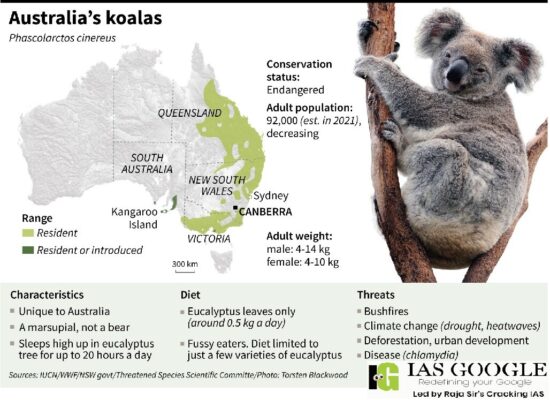 Koalas
Koalas
 Coastal Vulnerability Index
Coastal Vulnerability Index
- The maps determine the coastal risks due to future sea-level rise based on the physical and geological parameters for the Indian coast.
- The CVI uses the relative risk that physical changes will occur as sea-level rises are quantified based on parameters like:
- tidal range;
- wave height;
- coastal slope;
- coastal elevation;
- shoreline change rate;
- geomorphology; and
- historical rate of relative sea-level change
- From CVI, it can be delineated that Gujarat's 124 coastal kilometers is going to get affected or 5.36%, Maharashtra 11 km or 1.22% and then Karnataka & Goa 48 km or 9.54%, Odisha 37 km or 7.51%, West Bengal 49 km or 2.56%, Lakshadweep Islands 1 km or 0.81%, Andaman Islands 24 km or 0.96km and Nicobar Islands 8 km or 0.97%.
- Coastal vulnerability assessments can be useful information for coastal disaster management and building resilient coastal communities.
- India has a coastline of 7516.6 Km i.e., 6100 km of mainland coastline plus coastline of 1197 Indian islands touching 13 States and Union Territories (UTs).
- A coastal Multi-Hazard Vulnerability Mapping (MHVM) was also carried out using parameters like
- sea level change rate,
- shoreline change rate,
- high-resolution coastal elevation,
- extreme water level from tide gauges and their return periods.
- INCOIS is an autonomous organisation under the Ministry of Earth Sciences (MoES).
- It is located in Hyderabad & was established in 1999.
- It is a unit of the Earth System Science Organisation (ESSO), New Delhi.
- The ESSO operates as an executive arm of the Ministry of Earth Sciences (MoES) for its policies and programmes.
- It is mandated to provide the best possible ocean information and advisory services to society, industry, government agencies and the scientific community through sustained ocean observations and constant improvement through systematic and focused research.
- The astronomers from the Indian Institute of Astrophysics, an autonomous institute of the Department of Science & Technology, Govt. Of India, along with astronomers from BITS Pilani, Goa campus have devised a new approach -- an anomaly detection method.
 Multi-Stage Memetic Binary Tree Anomaly Identifier (MSMBTAI)
Multi-Stage Memetic Binary Tree Anomaly Identifier (MSMBTAI)
- The AI-based method, named Multi-Stage Memetic Binary Tree Anomaly Identifier (MSMBTAI), is based on a novel multi-stage memetic algorithm (MSMA).
- MSMA uses the generic notion of a meme, which is an idea or knowledge that gets transferred from one person to another by imitation.
- A meme indicates cross-cultural evolution in posterity and, therefore, can induce new learning mechanisms as generations pass.
- The algorithm can act as a quick screening tool for evaluating habitability perspectives from observed properties.
- The definition of “habitable zone” is the distance from a star at which liquid water could exist on orbiting planets’ surfaces.
- Habitable zones are also known as Goldilocks’ zones, where conditions might be just right – neither too hot nor too cold – for life.
- Because our Sun has nurtured life on Earth for nearly 4 billion years, conventional wisdom would suggest that stars like it would be prime candidates in the search for other potentially habitable worlds.
- Even the discovery of life beyond Earth is beyond the point: much in the way seeing the skies of a foreign land can make us feel like citizens of the world, coming to know these distant planets will usher us in as citizens of the universe.
 Who are minorities?
Who are minorities?
- The term “Minority” has nowhere been defined in the constitution.
- But Government notifies the minorities as per Section 2(c) of the National Commission for Minorities Act, 1992, and the Central Government has so far notified six communities as minority communities namely Christians, Sikhs, Muslims, Buddhists, Parsis and Jains.
- The Ministry of Minority Affairs which was carved out of Ministry of Social Justice and Empowerment is the apex body for the central government's regulatory and developmental programmes for the minority religious communities in India
- As per Census 2011, the literacy rate of the Minority Communities namely Christians, Jains, Sikhs and Buddhists is higher than the National Average of 72.98% except Muslims which is 68.54 %.
- The sex-ratio for Muslims in both rural and urban areas showed a decline between 2004-05 and 2009-10; however, those corresponding to Christians showed an improvement during this period.
- The Labour Force Participation Rate (LFPR) for male was much higher than female for all religious groups - the differential being greater in urban areas. The male-female differential in LFPR was the lowest among Christians.
- The LFPR for rural male, rural female and urban female was the highest for Christians while that for urban male was the highest for Sikhs.
- The unemployment rate in rural areas is less than that of urban areas. In rural areas, during 2009-10, unemployment rate was the highest for Christians for both males (3 per cent) and females (6 per cent). In urban areas, unemployment rate was the highest for Sikhs for both males (6 per cent) and females (8 per cent).
- Scholarship is provided to minority students for Professional and Technical courses, at Under Graduate and Post Graduate level, out of which 30% scholarship are earmarked for girls.
- Free Coaching and Allied Scheme - The Scheme aims to provide free coaching to students/candidates belonging to minority communities for qualifying in entrance examinations of technical/ medical professional courses and various Competitive examinations.
- Leadership development of women belonging to minority communities and non-minority communities (not exceeding 25% of each batch)
- Skill development scheme for youth of 14 - 35 years age group and aiming at providing employment and employment opportunities, improving the employability of existing workers, school dropouts etc.
- The UN Environment Programme (UNEP) says 8 million tonnes of plastic waste end up in our oceans every year, and forecasts suggest this could double by 2025 if we don’t take drastic action.
 About Plastic
About Plastic
- In 1907 the invention of Bakelite brought about a revolution in materials by introducing truly synthetic plastic resins into world commerce.
- By the end of the 20th century, plastics had been found to be persistent polluters of many environmental niches, from Mount Everest to the bottom of the sea.
- Plastic is a polymeric material—that is, a material whose molecules are very large, often resembling long chains made up of a seemingly endless series of interconnected links.
- Plastic pollution, accumulation in the environment of synthetic plastic products to the point that they create problems for wildlife and their habitats as well as for human populations.
- Synthetic plastics are largely nonbiodegradable, they tend to persist in natural environments.
- In the ocean, plastic pollution can kill marine mammals directly through entanglement in objects such as fishing gear, but it can also kill through ingestion, by being mistaken for food.
- Drainage systems become clogged with plastic bags, films, and other items, causing flooding.
- Wind-transported microplastic fibres and particles have been detected in snow deposited high atop mountains and on Arctic beaches and sea ice which acts as a helping hand in Climate Change.
- Phthalates are plasticizers—softeners used to make plastic products less brittle.
- They are found in medical devices, food packaging, automobile upholstery, flooring materials, and computers as well as in pharmaceuticals, perfumes, and cosmetics.
- BPA, used in the manufacture of clear, hard polycarbonate plastics and strong epoxy coatings and adhesives, is present in packaging, bottles, compact discs, medical devices, and the linings of food cans.
- PBDE is added to plastics as a flame retardant.
- All these compounds have been detected in humans and are known to disrupt the endocrine system.
- Plastic Fischer applying a principle of locally built, low-tech and low-cost, they created their “Trash Boom” – a floating barrage that is stretched across a river to capture plastic waste as the current takes it downstream.
- Plastic Fischer plans to rapidly scale up deployments in Indonesia, Viet Nam and India. The company will make open-source technology, to increase opportunities to capture plastic in rivers around the world.
- River Recycle, the business aims to install 500 cleaning and recycling points on the rivers that discharge the most plastic pollution into oceans. Communities hosting the company’s technology benefit not only from a cleaner environment, but also from new jobs created to service the recycling process. River Recycle’s projects include a facility on the Mithi River in Mumbai, India.
- The Blue Flag tag or Blue Flag certification is one of the world’s most recognised voluntary eco-labels. It is awarded to beaches, marinas and sustainable boating tourism operators.
- The certification is awarded by the Denmark-based non-profit Foundation for Environmental Education or FEE. It is awarded annually to beaches and marinas in FEE member countries.
- The Blue Flag beaches are considered the cleanest beaches in the world. Around fifty countries are currently participating in the program, and over 4,000 beaches, marinas, and boats have this certification.
- India aims to phase out single use plastic by 2022.
- The waste management infrastructure in the States/UTs is being strengthened through the Swachh Bharat Mission.
- The following steps have also been taken to strengthen implementation of Plastic Waste Management Rules, 2016 and also to reduce the use of identified single use plastic items:
- (i) the States/UTs have been requested to constitute a Special Task Force.
- (ii) A National Level Taskforce has also been constituted by the Ministry for taking coordinated efforts.
- The Government has also been taking measures for awareness generation towards elimination of single use plastics and effective implementation of Plastic Waste Management Rules, 2016. A two-month long Awareness Campaign of Single Use Plastic 2021has been organized.
- The India Plastic Challenge – Hackathon 2021, has been organized for students of Higher Educational Institutions and start-ups recognized under Start-up India Initiative.
- Creation of a modelling tool that allows governments to measure their plastic waste flows, behaviour change, policy financing and inclusion that really help support governments in their transition to a circular economy and removing that plastic waste and pollution from their nature, for good.
- There should be an aligned approach, allowing governments to work together collectively and then hopefully to join a system where there would be much higher, much more stringent requirements and ensuring accountability.
- Strengthening the Global Plastic Action Partnership, a public private platform that was born at the World Economic Forum, specifically to help governments to identify ways to address this issue and to provide training for plastic waste management.
- We need that global goal to be translated into a set of common global standards, rules, regulations – including bans, that the world can agree to.
- Plastic is a very practical product for a lot of purposes, and it will still be with us. But the problem, of course, is the way we use plastic when it ends up as plastic litter, when we throw it into nature, when it ends up in the oceans, and then it becomes a global phenomenon because the oceans move plastics around and the problem of one contributes to the problem of another country. We then drink the water, even if it's filtered, we eat the fish and eventually the plastics end up in us. So, plastics are not only the stuff you find lying around, it's even inside ourselves.
- We all need a global treaty that is bold. We should not fall short of ambition. To really build a beautiful world for ourselves, we need standards, goals, targets to support the implementation, and we also need to be very proactive in thinking about incentives and disincentives for change. One of the things we need to address is the cost economics, single use plastics, virgin material, life cycle assessments from production to usage.
- The Great Pacific Garbage Patch (GPGP) is the largest of the five offshore plastic accumulation zones in the world’s oceans. It is located halfway between Hawaii and California.
- It is estimated that 1.15 to 2.41 million tonnes of plastic are entering the ocean each year from rivers. More than half of this plastic is less dense than the water, meaning that it will not sink once it encounters the sea.
- The GPGP covers an estimated surface area of 1.6 million square kilometers, an area twice the size of Texas or three times the size of France.
- Due to seasonal and interannual variability of winds and currents, the GPGP’s location and shape are constantly changing. Only floating objects that are predominantly influenced by currents and less by winds were likely to remain within the patch.
- A total funding of $5 billion (over Rs 37,600 crore) will be required for the project. This amounts to an average of $625 million per year by 2030.
- At present, only 20 per cent of seabed has been mapped and studied, the UN agency in charge of ocean sciences said.
 Need for Sea-bed Mapping?
Need for Sea-bed Mapping?
- The repository of knowledge will be gained through studying the topology and depth of seafloors to identify the following:
- Location of ocean faults
- Workings of ocean currents and tides
- Transport of sediments
- Data gathered will help understand seismic and tsunami risks, sustainable fisheries resources, ways to deal with oil spills, air crashes and shipwrecks as well as potential for offshore infrastructure, according to UNESCO.
- They also have a major role to play in assessing the future effects of climate change, whether it be temperature increases or sea level rise.
- Research will propel technological advancements.,
- Multiple-beam sonars to measure water height at different points;
- intensifying the use of sonar on autonomous vessels;
- transmission of cartographic data
- Seafloor bathymetry is essential for safety of navigation and for establishing the limits of the extended continental shelf (ECS).
- Bathymetric data are also fundamental to our ability to model ocean circulation, with the predicted location of key circulation features,
- Precise seafloor information, foremost high-resolution bathymetric data, is required to work toward the goal of protecting at least 10% of the world’s oceans and to support the achievement of SDG 14 – Life below water – of the agenda 2030 for Sustainable Development.
- It will help in skill training and job creation.
- Navigation of autonomous underwater vehicles is more difficult than navigation of airborne and terrestrial platforms because GPS is not available.
- Even after collaboration at a scientific and technical level to share data, countries may face geo-political threat.
- The damage wouldn’t be confined to the ocean floor. Plumes of sediment will have a dire effect on sea life accustomed to clear water.
- Further, the plumes might also include toxins that can pass on to Fishes.
- The plumes might also reduce the ocean’s ability to sequester carbon—or even release stored carbon into the atmosphere—thereby worsening climate change.
- Lack of technological advancement and large-scale untapped resources in the oceans.
- Threat to marine life.
- Understanding the seafloor and associated processes is closely linked to its bathymetry. Mapping the gaps in the world’s oceans will better our knowledge of the seafloor and the oceans in general. This knowledge is a significant contribution to the development of sustainable ocean management plans and allows us to respond appropriately to modern challenges, such as environmental degradation in the marine realm, climate change, geohazards and a growing ocean industry.
- In sum, an increase in data gathering activities combined with effective targeting of future mapping programs and latest technology developments, as well as efficient data processing chains and mapping expertise will be needed if we are ever to deliver knowledge of the seafloor comparable to our knowledge of the land surface.
- At the same time, the informal economy plays a crucial role by cushioning the impact of shocks on the most vulnerable populations.
 Structural Vulnerabilities and what led to structural vulnerabilities?
Structural Vulnerabilities and what led to structural vulnerabilities?
- ‘Structural vulnerabilities’ can be defined as a country’s exposure to various economic and environmental shocks owing to its economic trajectory or certain geo-physical factors intrinsic to the economy.
- The economic shocks could include spillover effects of financial market disruptions or exchange rate shocks, arising in other parts of the world and disrupting the stability of domestic markets.
- At the same time, geo-physical features such as long coast lines, large extents of dry or semi-arid regions, and monsoon-dependence of agriculture, leave an economy vulnerable to frequent environmental shocks and the rising risks associated with climate change.
- It can limit the development opportunities of a country by generating inefficient resource use;
- Lowering savings and consumption rates (at a macro level);
- Increasing livelihood stresses like death or disease, loss of shelter, damage to property, and job losses; and
- Lowering business sentiments by causing the process of structural economic transformation to stagnate.
- Economic inequality despite rising income levels.
- Gender disparity.
- Unwarranted migration rates adding to population pressure.
- Increasing threats of climate change.
- To monitor the developing countries, the Committee for Development Policy (CDP), a subsidiary of the UN Department of Economic and Social Affairs (UNDESA), uses three criteria
- capturing their growth prospects,
- the vulnerabilities they are subject to, and
- their resilience towards these structural vulnerabilities.
- The UN established a separate category of Least Developed Countries (LDCs) in 1971 to cover low-income developing countries that are faced with structural economic, social and geo-physical constraints to achieving sustainable development.
- The UNDESA’s Economic and Environmental Vulnerability Index (EVI) provides a measurement of a country’s exposure to structural, geographical, and environmental shocks, without considering the transitory current domestic or international policies
- Another important measure of structural vulnerability is the Physical Vulnerability to Climate Change (PVCC) Index. It has a narrower scope and does not consider socio-economic challenges that impact the risks associated with climate change in developing countries.
- The bloc has remained substantially dormant since its inception because the member countries have been preoccupied with their own national development agenda, as well as contentious issues that carry geopolitical implications.
- Four out of the seven member countries—i.e., Bangladesh, Bhutan, Myanmar, and Nepal—belong to the LDC category.
- The year 2019 marked the beginning of the ‘decade of action’ for the 2030 Agenda. However, the progress of BIMSTEC economies over the last three years towards the SDGs has remained largely stagnant.
- The BIMSTEC countries therefore need to give renewed attention to the SDG framework. The countries can use the grouping as a platform to identify complementary strategies for SDG implementation and further development that will serve the interest of all its members.
- They can enhance cooperation across the key sectors that BIMSTEC has identified: trade, investment and development; environment and climate change; security; agriculture and food security; people-to-people linkages; science, technology and innovation; and connectivity.
- Addressing Structural Vulnerability through Economic Resilience and Sustainable Development
- Income growth, and improvements in education and health outcomes can substantially augment a country’s financial and human capital.
- Encouraging higher participation of women in the economy can lead to more efficient resource allocation and higher total factor productivity by driving the economy towards a more competitive market.
- Gender parity in labour force participation improves the economic opportunities for a large share of the population through the inclusion of women.
- Decreasing dependence on natural resources and preventing liquidation of a country’s natural assets, by increasing diversification of the export bundle through development of intermediate and finished goods industries not only reduces export concentration but is also in line with the ideas of sustainable development.
- Addressing large-scale unemployment in the economy can improve economic opportunities for those newly employed, reduce stress leading to improvements in health outcomes, and also improve business sentiments leading to higher economic growth.
- To combat structural vulnerabilities arising from environmental degradation or geophysical factors, conservation efforts are most crucial today. Besides infrastructural support in terms of monitoring and surveillance, rehabilitation and promotion of eco-tourism, ensuring participation of local communities can significantly aid conservation efforts.
- The 2030 Agenda for Sustainable Development recognises and internalizes this need for resilience and capacity-building through the inclusion of specific targets relating to disaster risk reduction.
- The imperatives for sustainable development of the BIMSTEC countries, enabling greater economic resilience-building against structural vulnerabilities, can be realized through renewed focus of the members on specific sectors of cooperation, namely, trade, investment and development; environment and climate change; and agriculture and food security.
- Cooperation to promote regional trade and investment can significantly improve the scope for growth of domestic industries as well as increase the stability of trade volumes and capital flows for all the countries within the region.
- BIMSTEC is a cooperation initiative involving seven countries, namely, Bangladesh, Bhutan, India, Myanmar, Nepal, Sri Lanka, and Thailand.
- The region is home to around 22 percent of the global population, with a combined GDP of approximately USD 3.7 trillion a year.
- The region has vast reserves of natural and human capital, which if mobilized in the right direction can significantly and sustainably augment its physical and social capital as well.
- This has crucial implications for the growth and development potential of the region.
- The Sustainable Development Goals (SDGs), also known as the Global Goals, were adopted by the United Nations in 2015 as a universal call to action to end poverty, protect the planet, and ensure that by 2030 all people enjoy peace and prosperity.
- The 17 SDGs are integrated—they recognize that action in one area will affect outcomes in others, and that development must balance social, economic and environmental sustainability.
- Countries have committed to prioritizing progress for those who're further behind. The SDGs are designed to end poverty, hunger, AIDS, and discrimination against women and girls.
- Creativity, knowhow, technology and financial resources from all of society is necessary to achieve SDGs in every context.
- As per data published by NCRB, total number of crimes against women during 2020 is 371503, out of which the number of cases registered under the Protection of Women from Domestic Violence Act, 2005 (PWDVA) during the year is 496.
 Why crimes against women?
Why crimes against women?
- Cultural lag due to which more women are participating in public sphere, more they subjecting to public ridiculing.
- Gender stereotyping and patriarchy
- Objectification and commodification through media.
- Economic dependence of women due to limited access to educational infrastructure.
- Globalization has increased the rate of violence against women due to changing value system and trans-national crime against women.
- Institutional weaknesses to curb violence against women.
- A total of 371,503 cases of crimes against women were registered across the country, citing data from the National Crime Records Bureau (NCRB).
- The data shows that in 2020, 398,620 persons were arrested in connection with crimes against women, 488,143 were charge-sheeted, and 31,402 were convicted.
- Instances of crimes against women in the cities went down by 8.3% in 2020 over the previous year.
- Among states and Union territories, Uttar Pradesh saw the highest number of such cases, with 49,385, followed by West Bengal (36,439), Rajasthan (34,535), Maharashtra (31,954) and Madhya Pradesh (25,640).
- According to the NCRB report and cited by the government, “Majority of cases under crimes against women were registered under [the category of] cruelty by husband or his relatives (30.2%), followed by assault on women with intent to outrage modesty (19.7%), kidnapping and abduction of women (19.0%), and rape (7.2%).”
- The Ministry of Women and Child Development implements One Stop Centre (OSC) scheme to provide integrated services such as medical assistance, police facilitation, legal counselling, psycho-social counselling and temporary shelter to women affected by violence under one roof.
- Ministry also implements Universalization of Women Helpline (WHL) Scheme, which provides 24-hour toll-free telecom service through short code181 to women seeking support and information.
- The Ministry also implements the Swadhar Greh Scheme which provides assistance to women victims of unfortunate circumstances including
- women victims of domestic violence, family tension or discord,
- who are made to leave their homes without any means of subsistence and have no special protection from exploitation,
- facing litigation on account of marital disputes,
- who are in need of institutional support for rehabilitation so that they can lead their life with dignity?
- The Scheme envisages providing shelter, food, clothing, health, counselling, awareness generation, behavioural training, legal aid and guidance etc. to such women.
- The Legal Services Authorities (LSA) Act, 1987 provides for free and competent legal services to the weaker sections of the society to beneficiaries, including women and children, to ensure opportunities for securing justice & are not denied to any citizen by reason of economic or other disabilities,
- Organize Lok Adalat to secure that the operation of the legal system promotes justice on a basis of equal opportunities.
- The legal services institutions like District / State / National Legal Services Authorities have been setup from the Taluk Court level to the Supreme Court.
- The Government has implemented Nyaya Bandhu (Pro-bono Legal Services) programme to link the persons eligible to avail free legal aid under LSA Act, 1987 with lawyers.
- Tele-law programme, being run by the Government, provides legal advice to the public including persons entitled for free legal aid at pre-litigation stage by the Panel Lawyers through CSCs at the Panchayats.
- As per section 8 of the Protection of Women from Domestic Violence Act, 2005, the State Governments are authorized to appoint such number of Protection Officers in each district as it may consider necessary.
- As such, the data regarding the details of such Protection Officers under PWDVA are maintained by the respective State Governments.
- Stringent/ active patrolling and vigilance, especially at night.
- More sensitized officials at all levels of justice.
- Neighbourhood committees to create “Zero Crime Zones” and actively promoting community policing.
- Fastrack courts for quick disposal of cases.
- Training in self defence.
- Gender sensitisation
- Moral overhauling
- Awareness creation for crime against women
- Provide better education.
- Violence against women is rampant in India, hinders educational attainment and earnings potential, and has significant economic and social costs. COVID-19 has exposed the fault lines of gender equality, with increases in the incidence of domestic violence during lockdown.
- Social programmes to sensitise men and boys on gender-related issues, and community-level platforms like SHGs should be strengthened to provide awareness on safety mechanisms for women, sexual and reproductive health, and family planning choices.
 Freedom Movement in Goa
Freedom Movement in Goa
- Goa became a Portuguese colony in 1510, when Admiral Afonso de Albuquerque defeated the forces of the sultan of Bjiapur, Yusuf Adil Shah.
- The next four and a half centuries saw one of Asia’s longest colonial encounters.
- Goa found itself at the intersection of competing regional and global powers and religious and cultural ferment that would lead eventually to the germination of a distinct Goan identity.
- By the turn of the twentieth century, Goa had started to witness an upsurge of nationalist sentiment opposed to Portugal’s colonial rule, in sync with the anti-British nationalist movement in the rest of India.
- Stalwarts such Tristão de Bragança Cunha, celebrated as the father of Goan nationalism, founded the Goa National Congress at the Calcutta session of the Indian National Congress in 1928.
- In 1946, the socialist leader Ram Manohar Lohia led a historic rally in Goa that gave a call for civil liberties and freedom, and eventual integration with India, which became a watershed moment in Goa’s freedom struggle.
- Prabhakar Sinari was a co-founder of the Azad Gomantak Dal (AGD) which was of the view that civil liberties could not be won by peaceful methods, and a more aggressive armed struggle was needed.
- The trauma of Partition and the massive rupture that followed, coupled with the war with Pakistan, kept the Government of India from opening another front in which the international community could get involved.
- It was apparent that Nehru was prepared for the long haul in Goa, perhaps trying to exhaust all options available to him given the circumstances that India was emerging from, and where he was headed in shaping India’s position in the comity of nations.
- Portugal had changed its constitution in 1951 to claim Goa not as a colonial possession, but as an overseas province.
- The move was apparently aimed at making Goa a part of the newly formed North Atlantic Treaty Organisation (NATO) military alliance.
- Nehru saw it prudent to pursue bilateral diplomatic measures with Portugal to negotiate a peaceful transfer while, at the same time, a more ‘overt’ indigenous push for liberation.
- The bill will allow survivors to sue their abusers in a public court even if they have signed employment agreements that require them to settle disputes internally through an arbitrator.
 What is forced arbitration?
What is forced arbitration?
- Often employee contracts contain arbitration provisions that limit what they are allowed to say in public about workplace disputes such as those pertaining to sexual harassment or racial discrimination.
- It allows companies to settle disputes through an arbitrator – an independent body, usually comprising lawyers or retired judges – behind closed doors, instead of allowing its employees to pursue legal action publicly.
- The Bill nulls both a pre-dispute arbitration agreement and pre-dispute joint-action waiver (which may or may not be part of the arbitration agreement).
- It defines pre-dispute arbitration agreement as “any agreement to arbitrate a dispute that had not yet arisen at the time of the making of the agreement”.
- It also defines pre-dispute joint-action waiver as an agreement that prohibits or waives the right of the employee to “take part in a joint, class, or collective action in a judicial, arbitral, administrative, or other forum, concerning a dispute”.
- While the Sexual Harassment of Women at Workplace Act 2013 does not have provisions for arbitration, similar criticisms have been made against the “internal committees” instituted by the Act to address grievances.
- The Justice Verma Committee in its 2013 report had found constituting in-house committees “counter-productive” as it may discourage victims from filing sexual harassment complaints. It had instead recommended forming an employment tribunal.
- The committee in its report had recommended deleting Section 10 of the Act, which allows for ‘conciliation’ if requested by the survivor to settle the dispute with the respondent before the internal committee launches an inquiry.
- In 2019, the National Commission for Women made a similar suggestion, stating that the provision may force women to withdraw a case to safeguard the honour of the workplace.
- An India Spend investigation in 2021 noted that despite the law the workers in the informal sector, which employs 95% of women, find it hard to access legal mechanisms to report sexual harassment.
- The conservation status of the marsupials was updated from ‘vulnerable’ to ‘endangered’ in Queensland, New South Wales and the Australian Capital Territory, based on the recommendation of the threatened species scientific committee.
 Koalas
Koalas
- According to fossil records, Koala species have inhabited parts of Australia for at least 25 million years but today, only one species remains — the Phascolarctos cinereus.
- They are found in the wild in the southeast and eastern sides of Australia — in coastal Queensland, New South Wales, South Australia and Victoria.
- Since Europeans first settled in the region, the Koala population has faced widespread habitat loss, particularly due to agriculture and the construction of urban settlements.
- They survive on a strict diet of up to a kilogram of eucalyptus leaves every day.
- Due to the low nutritional value of these leaves, koalas tend to sleep for extended periods, often up to 18 hours a day, to conserve energy.
- Australia’s Koala population has been on the road to extinction for over two decades now.
- The number of Koalas in NSW declined by between 33 per cent and 61 per cent since 2001, while in Queensland the Koala population decreased by at least half during the same period.
- Koalas were classified as “vulnerable” only in 2012.
- A major threat to Koalas is the spread of chlamydia, a sexually transmitted disease known to cause blindness and cysts in the koalas reproductive tract.









 Latest News
Latest News
 General Studies
General Studies